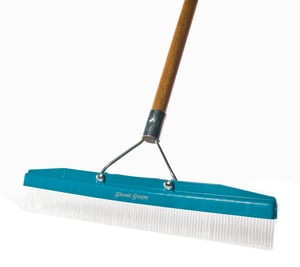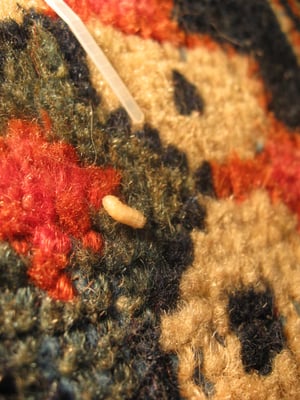With wool and other natural fibers being common in rugs, rug washers are aware to be on the lookout for these pests. Since natural fibers only make up about 1% of installed carpeting, cleaners who focus on carpet might give little thought to moths or carpet beetles. These insects feed on protein, mainly keratin, which can be found not only in wool, but in shed hair and skin including pet hair. Food spills can also contain protein that is food for the larvae. Leather is also protein based. Aniline leather with less protective coating than many other leather types is an attractive target. So, they may be attracted to heavily soiled carpet, upholstery and other fabrics where these items are present. They can also be attracted by and feed on spilled food and beverages. Although they don’t feed on body oils, or perspiration, these scents attract both moths and beetles.
Adult moths don’t eat wool or other material. They just mate and lay eggs in or near suitable food sources for the larvae to feed on when the eggs hatch. The larvae do the real damage. They eat a lot. Eventually making a cocoon and hatching into moths to repeat the cycle.
Clothing moths (these are the ones that eat wool) come in two varieties, case-making moths which are most common in the southern US and the webbing moth which has a much wider range.
Preventive Measures
The most effective way to prevent an infestation is to keep rugs, carpet and upholstery clean! Act quickly to remove spills that contain protein or other attractive soils. Carpet, rugs and upholstery should be vacuumed regularly. A thorough vacuuming does remove most eggs and larva from the materials. Use of a Grandi-Groom rake or Grandi Brush makes the vacuuming even more effective. ) In additional, professional cleaning every 12 to 24 months using hot water extraction provides an even more complete removal of insects. Hot water will kill some insects in all stages of their life cycle. Cleaning also removes the contaminants and odors that attract the bugs.
In most jurisdictions, claims to kill insects or other pests can only be business with the proper training, permits and licensing. Be sure to make statements in harmony with local law. Usually you can claim to remove or aid in preventing these pests.
Mothballs, crystals or flakes are not suggested. One reason is that mothballs don’t repel the insects, rather the vapors kill them. Damage may already be done before the mothballs become effective. Moth balls are based either on naphthalene or paradichlorobenzene. In addition to unpleasant odors that may linger for a long time, both pose the potential for adverse health effects.
Unlike most moths we see, clothing moths and carpet beetles are not attracted to light. They prefer dark and undisturbed places. Light, either artificial or sunlight, movement and air circulation all help inhibit moths and beetles from laying their eggs. When checking for moths and beetles, be sure to look under rugs, especially near edges. You may also want to disengage installed wool carpet to check for signs of insects on the underside where eggs could be laid undisturbed. When eggs have been laid on the back of rugs or carpet, the damage on the back may be far more significant than is seen on the face. 
If damaging insects are present, it is best to get rid of them before they attack valuable objects. They are common in homes and may be present before being noticed on carpets, rug or upholstery. In nature, both carpet beetles and clothing moths would feed on other animals nesting materials (mostly birds and small mammals), loose feathers, and also carcasses of other insects. Attics, eaves, gutters and wall cavities are all potential breeding grounds. Check carefully. Look for signs of activity any place you may see dead bugs. This would include partially eaten bugs, detached wings, and small fecal droppings.
Glue traps, either non-baited or scented with pheromones to attract moths, can be placed in suspect areas to confirm if you have an infestation or to alert you to a problem before you would be aware by other means.
Rug washers can apply a product to rugs after cleaning that makes the wool taste bad. Larvae will not eat the wool and essentially starve themselves to death. No pesticides or toxins are required (Resist Wool Preservative from Chem Max).
Control and Elimination
High heat for an extended time can kill moths and beetles. This is usually not practical. Storing rugs at temperatures of Oo F or colder for at least a week will kill all moths and carpet beetles. Temperatures of -2Oo F will do the job in 3 days. Rug washers with large chest type are walk-in freezers that can maintain those temperatures can offer this service. Since no toxins or pesticide is involve, it does not require special license or permit in many areas.
There is also a low-risk pesticide product (available as Resist Wool Pre-Treatment from Chem Max) that works well. The products is exempt from federal pesticide regulations due to the low risk but be sure to check local regulations.
